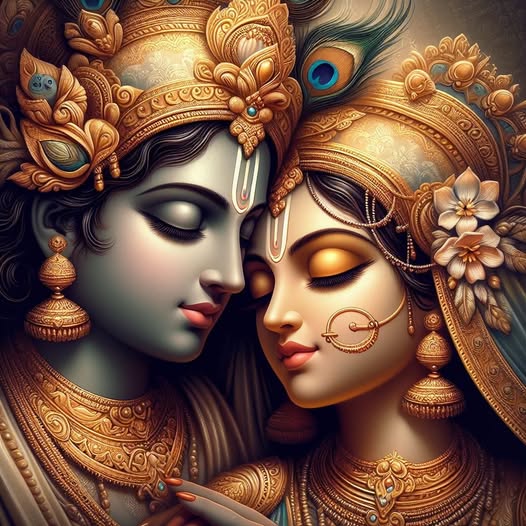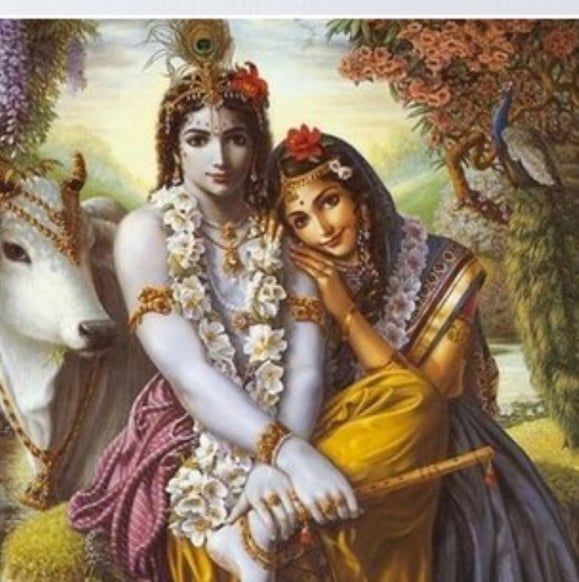The love between Radha and Krishna is considered one of the most beautiful and purest forms of love in Hindu mythology. This divine love, often referred to as "Radha-Krishna Prem" or "Radha-Krishna's Divine Love", transcends physical attraction and worldly attachments, embodying the highest spiritual ideal. Let’s explore why their love is regarded as pure and divine:
1. Spiritual Love and Divine Union:
Radha and Krishna’s love is not just romantic; it is deeply symbolic of the union of the individual soul (Jiva) with the Supreme Soul (Brahman). Krishna, as the Supreme God in the form of Vishnu, represents the infinite, while Radha represents the soul's yearning for union with the divine. Their love symbolizes the soul’s quest for liberation and its return to the divine source.
Their relationship exemplifies the concept of Bhakti (devotion), where Radha’s love for Krishna is not motivated by any material desire, but by pure selfless devotion to the divine. She is completely surrendered to Krishna, and in return, Krishna showers her with infinite love.
2. Purity of Heart and Mind:
Radha’s love for Krishna is often portrayed as a form of "selfless love". She does not love Krishna for any worldly gain or pleasure, but purely because of her deep devotion and connection to him. This kind of love is pure because it is not tainted by ego, jealousy, or attachment. Radha's love is an embodiment of the highest state of spiritual purity, where her heart is completely devoted to Krishna, without any expectation in return.
Krishna, too, responds to Radha’s love with equal devotion, acknowledging that the love between them is divine and beyond worldly understanding. His love for her represents the eternal bond between God and the soul. The love between Radha and Krishna teaches that true love is not bound by physical presence, time, or space; it is eternal and unconditional.
3. Separation and Longing:
One of the most important aspects of Radha and Krishna's love is the idea of longing and separation (known as "Viraha"). Radha’s separation from Krishna, whether through distance or the earthly constraints, deepens her devotion and love. The intense yearning that she feels for Krishna is symbolic of the soul’s yearning to reunite with the divine.
This longing and separation amplify the purity of their love because it represents a form of love that is untouched by the temporal world. Even when Radha is physically apart from Krishna, her heart is constantly united with him. This longing also leads to a deeper spiritual realization and an increased sense of closeness with the divine. Krishna, too, feels the longing of Radha, reflecting that true love is mutual and involves both unity and separation.
4. Unconditional Love:
Radha’s love for Krishna is unconditional. No matter the situation, her love remains unwavering. Even when Krishna engages in playful mischief with other gopis (milkmaids) or shows affection to other women, Radha's love does not waver, and she understands that his love for her is beyond the material realm. She embodies the essence of surrender (Sharanagati) to Krishna, accepting his divine nature and seeing him as the ultimate beloved.
5. Symbol of Devotion:
The love of Radha and Krishna is the epitome of Bhakti, or devotion. It is the love of a devotee who seeks the divine, not for personal rewards or material blessings, but out of pure love and surrender. In this sense, Radha represents the ideal devotee who is fully absorbed in the love of the divine, with no attachment to anything else.
This purity is demonstrated in various texts and stories, where Radha's devotion to Krishna remains constant, despite external challenges or the complexities of the world. Krishna himself acknowledges Radha’s devotion and love, and their bond is considered the highest form of divine love that anyone can aspire to.
6. The Dance of Divine Love - Rasa Lila:
One of the most famous expressions of Radha and Krishna’s love is through the Rasa Lila, a divine dance that they share with the gopis. The dance symbolizes the playfulness and joy of the divine love between Radha and Krishna. It is not a physical or romantic dance, but a spiritual one, where the gopis represent the individual souls, and Krishna is the Supreme Being. In this dance, Krishna multiplies himself to be with each gopi individually, representing the infinite nature of divine love that can be experienced by every devotee.
7. Radha as the Embodiment of Divine Feminine Energy:
Radha is often regarded as the Adi Shakti (primordial energy), the divine feminine force. Her love for Krishna reflects the ideal of the feminine energy that is both nurturing and transformative. This relationship is not just one of love but also of balance and harmony between the masculine (Krishna) and the feminine (Radha) energies. Together, they symbolize the complete union of these forces, creating a perfect whole.




